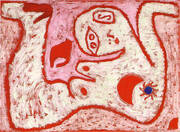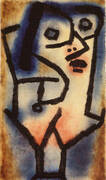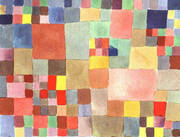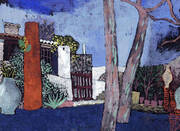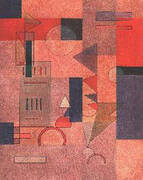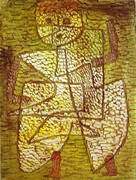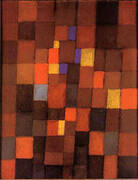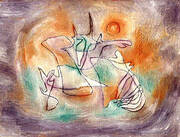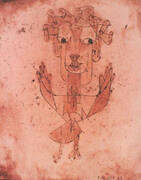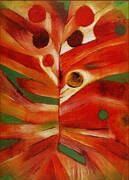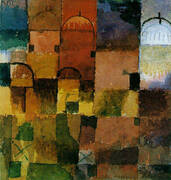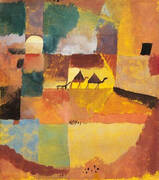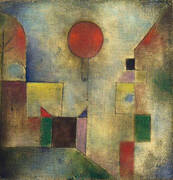Paul Klee Oil Painting Reproductions
Paul Klee replica paintings on Canvas for sale
Paul Klee Artworks: A Biography
Paul Klee was a celebrated Swiss and German painter. Influenced by various artistic styles, from cubism to expressionism and surrealism, he transformed abstract oil paintings.
We explore some of the most famous Paul Klee artworks alongside the artist’s intriguing personal life.
Where is Paul Klee from?
Born on 18 December 1879, in Münchenbuchsee in Switzerland. His father taught music, and Klee enjoyed playing the violin as a young man. Exceptionally talented, the Bern Music Association even invited Klee to play alongside them when he was just 11.
Despite this musical skill, Paul Klee adored painting. So he enrolled at the Akademie der Bildenden Künste München (the Academy of Fine Arts, Munich) in 1898.
What kind of artist was Paul Klee?
By 1905, the distinctive Paul Klee art style was already appearing. He was an intensely innovative and creative artist but also created compositions with extreme care and attention to detail.
He experimented with techniques such as drawing on blackened glass with a fine needle. This experimentation resulted in a set of etchings titled Inventions. These creations were his first exhibited works.
The following year (1906), he married Lily Stumpf. She was a Bavarian pianist, and they enjoyed a happy marriage together. The couple had one son named Felix Paul.
Paul Klee’s artworks developed slowly over the next few years. Finally, he held his first solo exhibition in Bern, Switzerland, in 1910.
His career took off in 1911. He met Alfred Kubin (the renowned art critic), who introduced Klee to European avant-garde circles.
In the winter of 1911, Klee started editing Der Blaue Reiter Journal. Founded by Wassily Kandinsky and Franz Marc, it was a period of intense intellectual and creative inspiration. The artist increasingly worked on color experiments, notably with watercolor landscapes. These paintings included works such as Flowerbed and In the Quarry (1913).
What was Paul Klee's art style?
An artistic breakthrough came after a 1914 visit to Tunisia. Inspired by North African light and color, he increasingly worked on abstract art paintings.
Abstract oil painting characterized Paul Klee’s art style from this point onwards.
This trip resulted in his first entirely abstract creation, In the Style of Kairouan (1914). Composed of vividly colored circles and rectangles, it marked a shift in Klee’s artistic production.
During World War One, Paul Klee’s art reflected on the death of his friends. Indeed, two Blaue Reiter artists (Franz Marc and Auguste Macke) died during the conflict. Klee also joined the German army in 1916. Like Franz Marc, he also painted camouflage for airplanes.
Towards the end of the conflict, however, he enjoyed critical artistic success. Now recognized as one of the most exciting young German artists, his art garnered high prices and acclaim. A three-year contract with the renowned art dealer Hans Goltz brought further commercial success.
What was Paul Klee famous for?
The artist is famous for his abstract art paintings. These include such iconic works as Paul Klee Castle and Sun (1928), Rhythmical Elements (1930), and Sphinx at Rest (1934).
The most famous Paul Klee painting is arguably Senecio (1922). Otherwise known as Head of a Man Going Senile, it depicts a round face divided into squares of vivid color.
Alongside Wassily Kandinsky, Klee taught at the Bauhaus School of Art and Design. He remained with the institution for a decade (1921-1931). In 1923, Klee also helped Kandinsky form the “Blue Four” artists group.
This group continued the earlier Blaue Reiter artistic focus, with Lyonel Feininger and Alexej von Jawlensky members. Klee also enjoyed his first exhibitions in Paris around this time.
What happened to Paul Klee?
In 1931, he moved to the Dusseldorf Academy. With the rise of the Nazi Party, however, Klee fell out of favor. Removed from his position just two years later, the family fled to Switzerland in late 1933.
Despite the chaotic international situation, Paul Klee enjoyed his most creative period in Switzerland. He created nearly 500 artworks in a single year. Struck from the List (1933) is one such painting. It highlights the uncertainty of Klee’s position around this time.
In 1935, he developed an autoimmune disease (scleroderma) which caused the hardening of the body’s connective tissue. This condition caused Paul Klee immense pain. As a result, many of his later artworks feature angels and preoccupations with death. Indeed, one of Klee’s last paintings, Death and Fire, depicts a skull with the German word for death appearing on its face.
Paul Klee died on 29 June 1940. He’d previously requested Swiss citizenship (despite being born in the country). Granted six days after his death, mourners buried him at Schosshaldenfriedhof, Bern, Switzerland.
Why was Paul Klee so important?
Paul Klee artworks are significant because they incorporate multiple artistic styles and approaches. Paul Klee's paintings are notoriously difficult to define and are associated with expressionism, futurism, surrealism, cubism, and abstraction.
While he had many artistic friends and colleagues, Klee mostly worked alone. He interpreted artistic trends in his unique manner. Klee consistently experimented with different media, painting on various surfaces with numerous tools.
This experimentation paved the way for many later artists to experiment with mixed media and abstract creations.
Paul Klee’s artworks are also known for their fragile and almost childlike quality. Famous for his cleverness and wit, Klee’s work is also highly playful and intelligent. They allude to poetry, music, dreams, politics, and mathematics. Speaking of Klee’s work, the poet Rainer Maria Rilke once wrote, “if you didn’t tell me he plays violin… I’d have guessed.”
Is Paul Klee a modern artist?
As an incredibly versatile and wide-ranging artist, he is a truly modern artist. He experimented with almost every significant avant-garde movement.
Despite this, Klee kept his distinctive artistic style. While he drew on modernist developments (particularly the work of Pablo Picasso and George Braque), he also humorously challenged many of art's “foundational” assumptions.
Alongside figures such as Wassily Kandinsky and Hilma Af Klint, he’s also one of Europe's first fathers of abstract oil painting.
Paul Klee art: abstract paintings for sale
If you love Paul Klee artworks, explore our extensive collection of his pioneering abstract oil painting. From famous works such as Paul Klee Castle and Sun to lesser-known creations spanning his career, you’ll find high-quality oil painting reproductions to add color and interest to any wall.
Testimonial from Larry Levine, Chicago IL.
Cannot Find What You Are Looking For?
Reproduction Gallery Information
Customer Service
(Send Us A Message)
Tel: (503) 937 2010
Fax: (503) 937 2011





